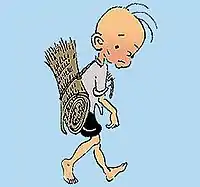| Sanmao 三毛 | |
|---|---|
 Sanmao | |
| Author(s) | Zhang Leping |
| Launch date | 1935 |
| Genre(s) | manhua, pantomime comic, gag-a-day |
Sanmao (Chinese: 三毛; pinyin: Sānmáo) is a manhua character created by Zhang Leping in 1935. He is one of the world's longest running cartoon characters and remains a landmark as one of the most famous and beloved fictional characters in China today.
The name Sanmao means "three hairs" in Chinese or "three mao" (a reference to his poverty). While the character has undergone a number of transitions over time, he has always been drawn with the trademark three strands of hair, which implies malnutrition as a result of poverty.
History

Most Chinese comic books prior to Sanmao featured adults and the Sanmao stories were also unusual in that they lacked dialogue and could therefore be classified as pantomime comics. When Zhang Leping created the manhua comic series, his main goal was to dramatize the confusion brought about to society by the Second Sino-Japanese War. He wanted to express his concern for the young victims of the war, particularly the orphans living on the streets. Most of the changes in the characters would come after World War II during the liberation in 1949.
Sanmao's image has evolved throughout time and in some modern continuation of the comics, he is depicted as a healthy, normal student.[1] The character has also been portrayed as living through some of the most important periods in Chinese history and during futuristic space explorations.
Story
The comic takes place mainly during the 1930s and early 1940s and is set in Old Shanghai in its "golden era". Sanmao lived mostly in misery and stark poverty against a backdrop of war, colonization, and inflation.
Adaptations
The character made his first appearance in comics and was later adapted into different formats.[2]
| Chinese title | English title | Year | Type | Location | Studio |
|---|---|---|---|---|---|
| 三毛欢乐派 | 2006 | Online game | China | ||
| 三毛流浪记 | Wanderings of Sanmao | 2006 | Cartoon | China Thailand | Shanghai Animation Film Studio |
| 三毛从军记 | 2005 | Stage production | China | ||
| 虚拟导游三毛 | 2005 | 3D | China | ||
| 三毛救孤记 | 2004 | Film | China | ||
| 三毛太空漫游 | 2000 | Theatrical | Hong Kong | ||
| 三毛新传 | 1999 | TV series | China | ||
| 三毛流浪记 | Adventures of Sanmao | 1997 | Stage production | Hong Kong | |
| 三毛流浪记 | Adventures of Sanmao | 1996 1998 | TV series | China Thailand | Shanghai Film Studio |
| 三毛从军记 | San Mao Joins the Army | 1992 | Film | China | |
| 三毛流浪记 | Adventures of Sanmao | 1990 | Drama | China | |
| 三毛流浪记 | Adventures of Sanmao | 1984 | Cartoon | China | |
| 三毛学生意 | 1958 | Film | China | ||
| 三毛流浪记 | Adventures of Sanmao | 1958 | Puppet film | China | |
| 三毛流浪记 | The Adventures of Sanmao the Waif | 1949 | Live-action film | China | Kunlun Film Company |
Further reading
- Farquhar, Mary Ann. "Sanmao: Classic Cartoons and Chinese Popular Culture" In Asian Popular Culture edited by John A. Lent (1995).
- Cunningham, Maura. "Sanmao Saturday: Introducing Zhang Leping and His Sanmao the Orphan Comics", blog 30 Aug 2014.[3]
- Cunningham, Maura. "Sanmao Learns from Lei Feng", blog 5 March 2013.[4]
Influence
- The renowned Taiwanese writer Chen Mao Ping (1943–91) chose "San Mao" as her pen name out of her deep sympathy for the lonely, homeless boy.
- The Hong Kong movie star Sammo Hung Kam-Bo was given the name Sammo because of his supposed resemblance to Sanmao.
References
- ↑ China Daily. "China Daily Archived 2007-02-05 at the Wayback Machine." "Sanmao Chinas favorite son turns 70." Retrieved on 2007-01-09.
- ↑ Sanmao Official Website. "Sanmao." "Production Listing." Retrieved on 2007-01-09.
- ↑ "Sanmao Saturday: Introducing Zhang Leping and His Sanmao the Orphan Comics". 30 August 2014.
- ↑ mauracunningham (5 March 2013). "Sanmao Learns from Lei Feng".
- ↑ 漫畫